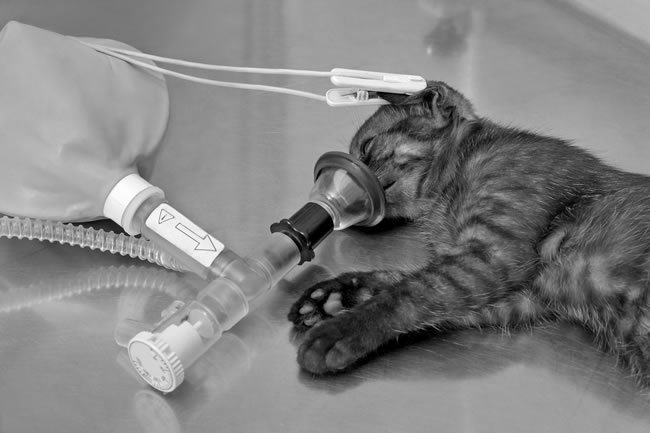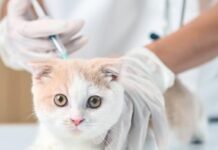If your cat needs to have anesthesia, you can rest easier about the procedure because it poses fewer risks today, thanks to newer drugs, precise monitoring and an increased number of board-specialized veterinarians.
Our discipline has evolved, says Luis Campoy, LV CertVA, MRCVS, Section Chief of Anesthesiology at Cornell University College of Veterinary Medicine.
In the 1990s, the overall mortality rate for cats undergoing anesthesia was .29 percent. That rate dropped to .24 percent overall by 2008 and was .11 percent for healthy cats. While that percentage may sound low, it equals approximately one death per 1,000 uses of anesthesia.
Survival Rates. That is a huge number, says Dr. Campoy, a diplomate of the European College of Veterinary Anaesthesia and Analgesia. The morality rate for humans is only .02 to .05 percent, so we know theres still a lot of room for improvement in the veterinary arena.
Some of the greatest progress has occurred simply in the practice of anesthesiology, he says. We are better at knowing which cats may pose a greater challenge and identifying what factors may pose a risk for general anesthesia. These include extremes of age and weight, the urgency and duration of the procedure, and the complexity of the surgery. Obviously, a six-hour procedure such as a very involved tumor removal will entail more labor-intensive anesthesia and involve a greater risk than a 20-minute spaying procedure.
At the same time, Dr. Campoy says, Veterinarians generally are becoming more proficient at recognizing when they are not equipped to deal with anesthetizing a particular cat and are more likely to ask for advice or to refer that patient to specialists. There have also been improvements in the drugs themselves. Drugs that are used nowadays have better margins of safety and a more refined pharmacodynamic and pharmacokinetic [movement through and out of the body] profile.
The increase in board-certified specialists in anesthesia means theyre sometimes available in private practices, not only in referral clinics and university hospitals. Upon graduation from veterinary school, they will have spent at least one year in a rotating internship and three years in a residency before passing a rigorous exam and receiving their board certification.
Photo: Bigstock

Contining Education. But their education doesnt end there, Dr. Campoy says. We attend annual worldwide meetings of veterinary anesthesiologists, sharing knowledge and experience, and publishing research specific to veterinary anesthesiology and analgesia. We are also getting better at talking to cat owners about the risks associated with anesthesia.
The ideal candidates are cats without co-morbidities, Dr. Campoy says. If there is a history of concurrent disease such as renal disease, heart problems or respiratory disease, the risk of mortality increases. Risks also increase for animals at the extremes – very heavy or very thin, and very young or very old cats.
Unfortunately, twice as many cats as dogs die during anesthesia. For cats, managing the airway poses a greater challenge and risk than in dogs, Dr. Campoy says. Cats have tiny and very reactive airways, so instrumentation can be challenging.
Emergency procedures present an even greater risk because there may be less time to take a detailed history or explore options. For example, if a patient presents with profuse, life-threatening bleeding, you need to go into life-saving mode and act quickly, says Dr. Campoy.
Medical History. For less urgent situations, however, the time spent taking a thorough medical history can be well spent. I cant stress its importance enough, says Dr. Campoy. An observant owner who reports the full details on their cats condition can provide valuable clues about their pets health that in turn may impact our anesthetic plan.
For example, if we know that a cat has been having difficulty eating or showing signs of pain when opening his mouth, then we will have a much better idea of how to prepare for and manage a potential difficult airway when putting this cat under general anesthesia. Report all changes to your cats veterinarian or specialist – anything from a simple cough to more serious symptoms. Something you think might be trivial might end up being important.
In deciding on a specific anesthesia, there is a common misconception that many drugs are available. In actuality, there arent many, Dr. Campoy says. Our choices have more to do with individual case management. In all cases, we want to be sure the patient is well oxygenated, well hydrated and well monitored, with adequate blood pressure. There is no one-size-fits-all management plan.
Cornell

More Vital Than Drugs. In fact, case management is often more significant than the drugs used, Dr. Campoy says. For example, we need to ensure that our equipment is in perfect working order. You can have the best anesthesia in the world, but if your equipment fails to deliver oxygen, you may be putting your patients life at risk from hypoxia [deprivation of oxygen].
Another risk: If food and water havent been withheld beforehand, the patient can vomit and inhale them into the lungs, and develop aspiration pneumonitis.
Advanced monitoring is helping to lower the risks, Dr. Campoy says. We have now affordable equipment that will monitor oxygenation, cardiac electrical activity, blood pressure, respiratory function and body temperature – all at once!
Todays better-informed pet owners are also improving patient care. They will often point out to their veterinarians something that is done in human practice and question why they cant do the same for their pet, Dr. Campoy says. In doing so, they help drive the specialty forward. We are seeing more challenging cases and longer procedures, such as traffic accidents that may involve a shattered hip, broken leg bones and massive hemorrhage. In the past, these animals may not have even made it to the ER. But today, more owners are willing to invest the time and money to help get their cats back to full health. So diagnostics, medicine, anesthesia and surgery have all evolved together.
As challenging as his work is, it is also richly rewarding, especially when a patient survives serious injury. We recently had a cat undergo extensive dental surgery. The cat suffered a reaction to a drug that had been administered. It was a big challenge that initially looked very grim. Although it probably took a chunk of my lifespan, too, that cat made it!
Board-certified members of the American College of Veterinary Anesthesiologists and Analgesia are listed by area at www.acvaa.org.



